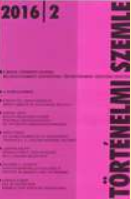Dózsa György, Jean Hannart és a „ceglédi kiáltvány” - Három újabb forrás az 1514. évi parasztháború eseménytörténetéhez
György Dózsa, Jean Hannart and the „Cegléd Manifesto”. Three New Sources on the Events of the 1514 Hungarian Peasant War
Author(s): Bálint LakatosSubject(s): Military history, 16th Century, Philology
Published by: Magyar Tudományos Akadémia Bölcsészettudományi Kutatóközpont Történettudományi Intézet
Keywords: György Dózsa; Jean Hannart; Cegléd Manifesto; Hungarian Peasant War; 1514; history;
Summary/Abstract: While the history of the 1514 Hungarian Peasant War has sufficiently been explored, we have relatively few sources on the first phase of the process whereby the anti-Ottoman crusade was transformed into a revolt. Therein lays the importance of a newly discovered French report, which was written by Jean Hannart to Margaret of Austria, daughter of emperor Maximilian of Habsburg, then regent of the Low Countries, from Vienna on 17 June 1514. (The report and its annexes are now kept in a modern copy in the Archives départementales de Nord at Lille.) Upon imperial command, Hannart escorted archduchess Mary, fiancée of prince Louis of Hungary, who had traveled from the Low Countries to Vienna in preparation of the Habsburg–Jagiello marriage treaty of 1515, and reported in his letter about the successful accomplishment of his journey. Additionally, he also informed the regent about the disturbances in Hungary: the crusade proclaimed by cardinal Thomas Bakócz, archbishop of Esztergom and papal legate, had ushered in a revolt, and the crusaders attacked the nobility and the high clergy. Hannart attached a Latin manuscript document to his report (regent Margaret did not read German), which shows similarities with the already known German reports and printed pamphlets, but its text is different and contains some new pieces of information. I have previously demonstrated that in the European circulation of reports about the Hungarian events Vienna played the role of a news-center: information gathered at Buda flowed there and spread therefrom towards Western Europe. The flow of information was carried by manuscript reports, some of which were later printed as pamphlets. The newly discovered report must equally have been written in Vienna in early June, and also has an attachment: a new copy of the manifesto drafted in the name of the rebel leader György Dózsa, which is known on account of its dating place as the „Cegléd manifesto”. Its text is one of our key sources for establishing the self-identification of the rebels, which has so far only been known from another undated copy preserved in the city archives of Bártfa (now Bardejov in Slovakia). The „Cegléd manifesto” was thoroughly analysed by Jenő Szűcs in 1972. He connected its origin to the crusader attack on Buda in June 1514, and supposed that it may have been dispatched in the name of Dózsa by his brother Gregory in several copies from Cegléd between 10 and 21 June. Szűcs interpreted the manifesto as the ideological summary of the peasant war. Yet the newly discovered copy of the „Cegléd manifesto” clearly refutes his theory. The manifesto was written on 25 May, and issued in Dózsa’s name by one of his deputy commanders called Michal magister. Moreover, there is no question of any „ideological program”: chronology and textual correspondences both prove that it was drafted in answer to the order of cardinal Bakócz of 15 May, by which he banned the recruitment. The two copies of the „Cegléd manifesto” are not identically worded. Analysing the divergences philologically, I have come to the conclusion that the manifesto was originally prepared in several, presumably already different exemplars, and then circulated in further copies. Therefore, the two copies we have now were probably copied at Buda from two different versions, and thus their divergences seem inevitable. The origins of the Bártfa copy could also be reconstructed: according to the testimony of its handwriting it was prepared by town notary Fabian Eisenperger at Buda in the first half of July, when he and fellow townsman Leonhard Stöckel paid in the name of their community the tax levied for the war against the rebels. (The verse on the back of this copy, a Latin epitaph of bishop Miklós Bátori of Vác, may equally have been recorded then, on their way back home.) Hannart’s report thus offers a unique opportunity to follow textually from the „Cegléd manifesto” through the report to the ambassadorial dispatch the evolution of news into narrative
Journal: Történelmi Szemle
- Issue Year: 2016
- Issue No: 02
- Page Range: 277-302
- Page Count: 26
- Language: Hungarian

